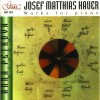Composers
Josef Matthias Hauer (March 19, 1883 – September 22, 1959) was an Austrian composer and music theorist. He is most famous for developing, independent of and a year or two before Arnold Schoenberg, a method for composing with all 12 notes of the chromatic scale. Hauer was also an important early theorist of twelve-tone music and composition.
Hauer "detested all art that expressed ideas, programmes or feelings,"[2] instead believing that it was "essential...to raise music to its highest...level," [3] a, "purely spiritual, supersensual music composed according to impersonal rules,"[4] and many of his compositions reflect this in their direct, often athematic, 'cerebral' approach. Hauer's music is diverse, however, and not all of it embraces this aesthetic position.
According to one scholar, Hauer's twelve-tone music was balanced between the "obligatory rule" that each composition follow an arrangement of the total chromatic: "the 'Constellation' or "Grundgestalt' ('basic shape')," and his often emphasized concept of tropes, or unordered arrangement of a pair of hexachords.[5] This interpretation seems largely drawn from Hauer's theoretical writing of the early to mid-1920s in which he outlines these techniques. But a closer look at Hauer's compositional output reveals that a significant portion of his twelve-tone music from the 1920s and 1930s employs strictly ordered rows, as do the Zwoelftonspiel pieces that follow.[6] Despite this, Hauer is often mentioned as the inventor of the tropes in contrast to the Arnold Schoenberg and the Second Viennese School, who are thought of as advocates of Schoenberg's twelve-tone method. (In fact, many of the twelve-tone pieces by Schoenberg and his student Alban Berg do not strictly follow this method.)
Recently Added
| Country: | Austria |
| Period: | Middle Ages |
Biography
Josef Matthias Hauer (March 19, 1883 – September 22, 1959) was an Austrian composer and music theorist. He is most famous for developing, independent of and a year or two before Arnold Schoenberg, a method for composing with all 12 notes of the chromatic scale. Hauer was also an important early theorist of twelve-tone music and composition.
Hauer "detested all art that expressed ideas, programmes or feelings,"[2] instead believing that it was "essential...to raise music to its highest...level," [3] a, "purely spiritual, supersensual music composed according to impersonal rules,"[4] and many of his compositions reflect this in their direct, often athematic, 'cerebral' approach. Hauer's music is diverse, however, and not all of it embraces this aesthetic position.
According to one scholar, Hauer's twelve-tone music was balanced between the "obligatory rule" that each composition follow an arrangement of the total chromatic: "the 'Constellation' or "Grundgestalt' ('basic shape')," and his often emphasized concept of tropes, or unordered arrangement of a pair of hexachords.[5] This interpretation seems largely drawn from Hauer's theoretical writing of the early to mid-1920s in which he outlines these techniques. But a closer look at Hauer's compositional output reveals that a significant portion of his twelve-tone music from the 1920s and 1930s employs strictly ordered rows, as do the Zwoelftonspiel pieces that follow.[6] Despite this, Hauer is often mentioned as the inventor of the tropes in contrast to the Arnold Schoenberg and the Second Viennese School, who are thought of as advocates of Schoenberg's twelve-tone method. (In fact, many of the twelve-tone pieces by Schoenberg and his student Alban Berg do not strictly follow this method.)



